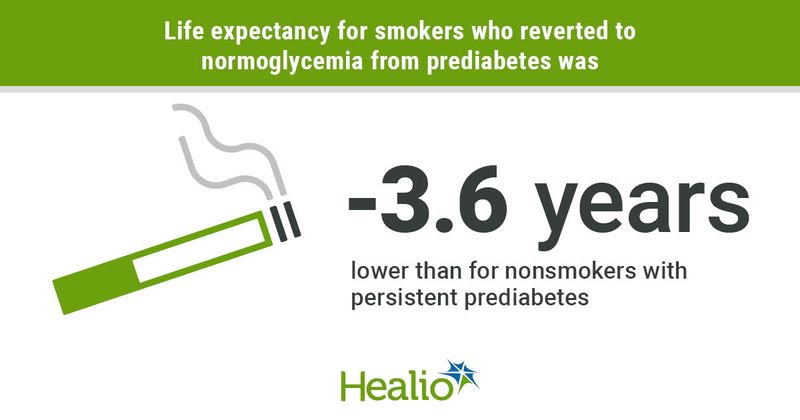Lifestyle modification necessary to lower mortality risk for adults with prediabetes
Key takeaways:
- Adults who revert from prediabetes to normoglycemia have a similar mortality risk as those with persistent prediabetes.
- Not smoking and exercising more, along with lowering glucose, can reduce mortality risk.
Adults who improve from prediabetes to normoglycemia do not have a lower risk for death compared with those with persistent prediabetes, but lifestyle modification can help reduce mortality risk, according to study data.

“The findings of this study highlighted the significance of lifestyle modifications for those who are in prediabetes status, offering healthcare providers new evidence on identifying populations that may benefit more from certain lifestyle modifications,” Xifeng Wu, MD, PhD, dean of the school of public health and vice president of The Second Affiliated Hospital of Zhejiang University School of Medicine; and director at the Director, National Institute for Data Science in Health and Medicine of Zhejiang University in China, told Healio. “Additionally, healthcare providers should monitor individuals with prediabetes closely and provide appropriate lifestyle advice to prevent the progression to type 2 diabetes.”

Researchers conducted a prospective cohort study of 45,782 adults in Taiwan who had prediabetes during an initial clinic visit between 1996 and 2007 (62.9% men; mean age, 44.6 years). Clinic visits included a self-administered questionnaire on demographics, lifestyle and medical history; anthropometric measurements; physical examinations; blood tests and urinary tests.
The findings were published in JAMA Network Open.
During a follow-up 1 to 3 years after the first visit, participants had blood samples assessed again. Prediabetes was defined as a fasting plasma glucose of 100 mg/dL to 125 mg/dL. Diabetes was defined as an FPG of 126 mg/dL or higher, a physician’s diagnosis of diabetes or the use of diabetes medications.
Participants were placed into three groups: progression from prediabetes at baseline to diabetes at follow-up, persistent prediabetes at both visits, and reversion from prediabetes at baseline to normoglycemia at follow-up. Mortality data were obtained from Taiwan death files. Participants were followed until Dec. 31, 2011.
Of the cohort, 37.2% reverted to normoglycemia within 3 years of their initial visit, whereas 3.9% developed type 2 diabetes. During a median follow-up of 8 years, 1,528 adults died, the researchers reported.
The all-cause mortality rate was highest among adults who progressed to diabetes (9.65 per 1,000 person-years), followed by those who had persistent prediabetes (4.29 per 1,000 person-years) and adults who reverted to normoglycemia (3.26 per 1,000 person-years). A similar pattern was seen for cancer-related death and cardiovascular disease-related death.
After adjusting for covariates, progression to diabetes was associated with a higher risk for all-cause mortality (HR = 1.5; 95% CI, 1.25-1.79) and CVD-related mortality (HR = 1.61; 95% CI, 1.12-2.33) than having persistent prediabetes. The risk for all-cause mortality was similar between adults with persistent prediabetes and those who reverted to normoglycemia, according to the study.
“It was surprising that we found reversion from prediabetes to normoglycemia did not lower the risk of death compared to individuals with persistent prediabetes,” Wu said. “However, this does not necessarily mean that lowering blood glucose levels is useless.”
When modifiable risk factors were analyzed, adults who reverted to normoglycemia and were physically active had a lower risk for all-cause mortality than those with persistent prediabetes who were inactive (HR = 0.72; 95% CI, 0.59-0.87). Adults who reverted to normoglycemia and were current smokers had a higher risk for death than those with persistent prediabetes who never smoked (HR = 1.6; 95% CI, 1.31-1.96). Among adults who reverted to normoglycemia, those who were physically active had a lower risk for death than those who were moderately active (HR = 0.71; 95% CI, 0.57-0.88), the researchers wrote.
Adults who reverted to normoglycemia who remained physically active had a life expectancy 2.5 years longer than those with persistent prediabetes who were not physically active. However, adults who reverted to normoglycemia and were currently smoking had a 3.6-year lower life expectancy than those with persistent prediabetes who never smoked.
“Future studies may be needed to investigate the effects of reversion from prediabetes to normoglycemia on the incidence of major chronic diseases, such as cancer and cardiovascular diseases,” Wu said. “Investigating the time-varying effects of change in prediabetes status on morbidity and mortality may also be an interesting idea.”
For more information:
Xifeng Wu, MD, PhD, can be reached at wenyuanli@zju.edu.cn.
